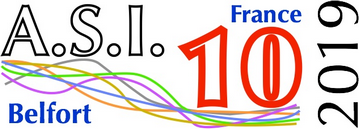|
 The 10th International Conference, to give continuation to previous meetings:
The 10th International Conference, to give continuation to previous meetings:
|
|
Origin and development of S.I.A.
Let us recall that this method of non-symmetrical
data analysis allows us to extract and structure knowledge in the form
of rules and general rules using a set of data that connects a population
of subjects (or objects) with a set of variables. This method stems from
the statistical modelling of the quasi-implication: if a given variable
or conjunction of variables "a" is noticed among the population,
then, in general, so will be variable "b". The variables referred
to can be of various types: binary, modal, numerical, interval, etc. Contrary
to the methods of symmetrical analysis based, for instance, on distance
or correlation, groups of acquired rules can lead to hypotheses of causality.
These groups are structured according to different supplementary approaches
(implicative graph, oriented hierarchy). The quantitative determination
of subjects or descriptors responsible for these structures is determined
by their contribution or their typicality. Finally, the results and their
interpretation can be readily visualized by means of the CHIC software
(Classification Hiérarchique Implicative and Cohésitive).
Gras R., Suzuki E., Guillet F. and Spagnolo F.
(Eds) (2008) Statistical Implicative Analysis, Springer-Verlag,
Berlin-Heidelberg Consultable : http://www.springer.com/engineering/book/978-3-540-78982-6
Orus P., Zamora L., Gregori P. (Eds) (2009) Teoria y Aplicaciones del Analisis Estadistico Implicativo, Universitat Jaume-1, Castellon (Espagne) Régnier J.C., Gras R., Spagnolo F., Di Paola
B. (Eds) (2011) Analyse Statistique Implicative: Objet de recherche
et de formation en analyse des données, outil pour la recherche
multidisciplinaire. Prolongement des débats. QRDM Quaderni
di Ricerca in Didattica - GRIM ISSN on-line 1592-4424, Palerme:
Université de Palerme. https://sites.unipa.it/grim/QRDM_20_Suppl_1.htm Régnier J.C., Bailleul, M., Gras R.(Eds) (2012) Analyse Statistique Implicative: de l'exploratoire au confirmatoire. ISBN 978-2-7466-5256-9 Caen : IUFM de l'Université de Caen. https://sites.unipa.it/grim/QRDM_22_Suppl_2.htm Gras R., Régnier J.-C., Marinica, C., Guillet F. (Eds) (2013) Analyse Statistique Implicative. Méthode exploratoire et confirmatoire à la recherche de causalités. Toulouse: Cépaduès Editions http://www.cepadues.com/pages/Livre/Livre.aspx?ID=745 Régnier J.C., Ag Almouloud, S., Gras R.(Eds) (2013) Analyse Statistique Implicative. Cadre théorique et applicatif pour l’exploration sémantique et non symétrique des données. São Paulo : PUC/PPGEM http://revistas.pucsp.br/index.php/emp/issue/view/1271 Régnier, J.C., Slimani, Y., Gras, R., Ben Tarbout, I., Dhouibi, A. (Eds) (2015). Analyse statistique implicative. Des sciences dures aux sciences humaines et sociales. Tunisie. ARSA Association pour la Recherche en Statistique Appliquée ISBN 978-9973-9819-0-5. (1ère édition) - QRDM - "QUADERNI DI RICERCA IN DIDATTICA" - G.R.I.M. Supplemento n.1 al N.25- PALERMO 2015 (2ème édition)
Télécharger 2ème édition : http://math.unipa.it/%7Egrim/quaderno25_suppl_1.htm Télécharger 1ère édition : http://sites.univ-lyon2.fr/asi/8/pub/ISBN9789973981905ASI8.pdf
Gras, R., Régnier, JC., Lahanier-Reuter, D. Marinica, C., Guillet, F. (Eds) (2017) Analyse Statistique Implicative. Des Sciences dures aux Sciences Humaines et Sociales. Toulouse : Cépadues Régnier, J.C., Gras, R., Couturier,R., Bodin, A. (Eds) (2017). Analyse statistique implicative. Points de vue conceptuels, applicatifs et métaphoriques.. France: Université de Bourgogne-Franche Comté. Version imprimée: ISBN 978-2-9562045-0-3. Version numérique: ISBN 978-2-9562045-1-0 Télécharger la version numérique : http://sites.univ-lyon2.fr/asi/9/pub/ISBN9782956204510ASI9.pdf Gras, R., (2018) La théorie de l'analyse statistique implicative ou l'invraisemblance du faux. Toulouse : Cépadues |
| Last update : 22/05/2021 |
| Webmaster : Jean-Claude REGNIER et Rafael RAMIRES JAQUES |
| Responsable scientifique : Jean-Claude REGNIER |
| Conception du logotype ASI10 : Vladimir LIRA VERAS XAVIER DE ANDRADE |